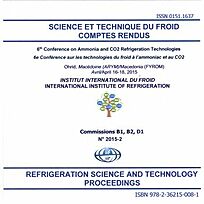
Document IIF
Experience with ejector work recovery and auxiliary compressors in CO2 refrigeration systems. Technological aspects and application perspectives.
Numéro : pap. n. 24
Auteurs : MINETTO S., GIROTTO S., ROSSETTI A., et al.
Résumé
A recent development of CO2 booster commercial refrigeration systems, based on the adoption of ejectors for liquid pumping and suction vapour pre-compression in an economized cycle, has demonstrated to be a viable option to overcome the main issue associated with the use of CO2 in warm ambient conditions, thus promoting the diffusion of CO2 in Southern Europe. At least 20 systems using ejectors are in operation at the moment, with different layouts. Some of them incorporate both ejectors and auxiliary compressors. Data from the field are available to support expected performances; as a matter of fact, the adopted solution is gaining popularity. This paper summarises the experience acquired during the development of these innovations, also focusing on technological aspects, presents some results from the field and faces the issue of moving towards a simplified design. Simplification and standardisation of the high-efficiency CO2 solution are considered essential to successfully spread the proposal to countries where synthetic refrigerants are nowadays the first choice, also for economic reasons.
Documents disponibles
Format PDF
Pages : 8 p.
Disponible
Prix public
20 €
Prix membre*
15 €
* meilleur tarif applicable selon le type d'adhésion (voir le détail des avantages des adhésions individuelles et collectives)
Détails
- Titre original : Experience with ejector work recovery and auxiliary compressors in CO2 refrigeration systems. Technological aspects and application perspectives.
- Identifiant de la fiche : 30014626
- Langues : Anglais
- Sujet : Technologie, Généralités
- Source : 6th Conference on Ammonia and CO2 Refrigeration Technology. Proceedings: Ohrid, North Macedonia, April 16-18, 2015.
- Date d'édition : 16/04/2015
Liens
Voir d'autres communications du même compte rendu (53)
Voir le compte rendu de la conférence
Indexation
-
A novel transcritical CO2 refrigeration cycle w...
- Auteurs : CEN J., LIU P., JIANG F.
- Date : 12/2012
- Langues : Anglais
- Source : International Journal of Refrigeration - Revue Internationale du Froid - vol. 35 - n. 8
- Formats : PDF
Voir la fiche
-
Preliminary experimental investigation on a tra...
- Auteurs : GULLO P., KÆRN M. R., BIRKELUND M., KRIEZI E. E.
- Date : 07/12/2020
- Langues : Anglais
- Source : 14th IIR-Gustav Lorentzen Conference on Natural Refrigerants (GL2020). Proceedings. Kyoto, Japon, December 7-9th 2020.
- Formats : PDF
Voir la fiche
-
Experimental test rig for the visualisation stu...
- Auteurs : BODYS J., PALACZ M., HAIDA M., SMOLKA J., NOWAK A. J.
- Date : 05/2021
- Langues : Anglais
- Source : 2021 Purdue Conferences. 18th International Refrigeration and Air-Conditioning Conference at Purdue.
- Formats : PDF
Voir la fiche
-
Multi ejector and the impact of ejector design ...
- Auteurs : KRIEZI E. E., FREDSLUND K, BANASIAK K., et al.
- Date : 16/04/2015
- Langues : Anglais
- Source : 6th Conference on Ammonia and CO2 Refrigeration Technology. Proceedings: Ohrid, North Macedonia, April 16-18, 2015.
- Formats : PDF
Voir la fiche
-
Untersuchung von CO2-Ejektoren beim Einsatz in ...
- Auteurs : FIORENZANO de ALBUQUERQUE R., TISCHENDORF C., LEMKE N., et al.
- Date : 06/2010
- Langues : Allemand
- Source : KI Kälte Luft Klimatechnik - vol. 46 - n. 6
Voir la fiche
